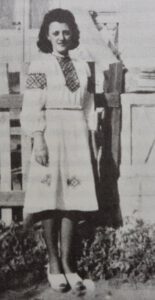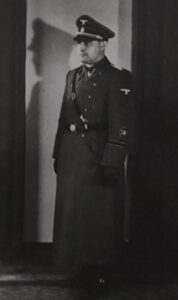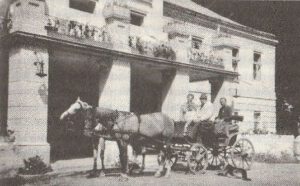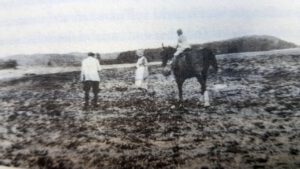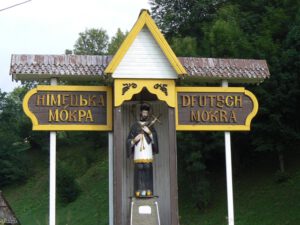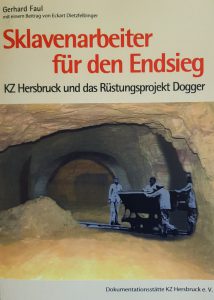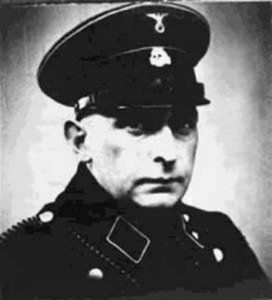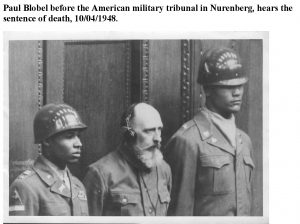– Text / Tekst in: Deutsch English Polski –
[DE] Leopold Mitas wächst im niederösterreichischen Weinviertel auf. Nach der Volksschule wird er zum Herrschafts- und Kammerdiener im Schloss des Grafen Schönborn ausgebildet. Danach findet er nur als Erntehelfer noch Arbeit. Eine Perspektive bietet ihm die Anstellung bei der Polizei, bei der er sich 1921 bewirbt … [Unten]
[EN] Leopold Mitas grew up in the Weinviertel region of Lower Austria. After primary school he is trained as a court and chamber servant in the castle of Count Schönborn. Afterwards he only finds work as a harvest helper. A perspective offers him a job with the police, to which he applies in 1921 … [Below]
[PL] Leopold Mitas dorastał w regionie Weinviertel w Dolnej Austrii. Po ukończeniu szkoły podstawowej kształci się w zamku hrabiego Schönborna na lokaja i kamerdynera. Potem jednak znajduje pracę tylko jako pomocnik przy żniwach. Dobre perspektywy daje mu praca w policji, o którą ubiega się w 1921 roku … [Poniżej]
[DE] Leopold Mitas wächst im niederösterreichischen Weinviertel auf. Nach der Volksschule wird er zum Herrschafts- und Kammerdiener im Schloss des Grafen Schönborn ausgebildet. Danach findet er nur als Erntehelfer noch Arbeit. Eine Perspektive bietet ihm die Anstellung bei der Polizei, bei der er sich 1921 bewirbt. Von seiner Ausbildung und weiteren Tätigkeit als Schutzpolizist sind keine Auffälligkeiten bekannt. 1932 tritt er der NSDAP bei, die von einer Kleinstpartei jetzt zu einer Massenpartei wird. Auch mit Terrorakten versucht die NSDAP (Hitlerbewegung), in Österreich an die Macht zu kommen. Die Bundesregierung unter dem autoritär regierenden Bundeskanzler Dollfuß verbietet daraufhin im Sommer 1933 die Partei. NS-Sympathisanten im Staatsdienst werden pensioniert und bis Sommer 1934 gibt es rund 50.000 Verurteilungen wegen illegaler Aktivitäten und Terrorakten. Am 25.7.1934 töten die Nazis Dollfuß bei einem Putschversuch. Mitas selbst verhält sich während des Parteiverbots still und zahlt auch keine Mitgliedsbeiträge mehr. Als aber 1938 Österreich dem „Großdeutschen Reich“ einverleibt wird, bewirbt Mitas sich sofort wieder bei der Partei und wird auch als „alter Kämpfer“ aufgenommen.
Mitas und seiner Frau – der acht Jahre älteren Katharina Winkler – scheint 1939 eine glänzende Zukunft auf der Seite der Gewinner, der Nazis, zu winken – trotzdem kommt seine Karriere nicht richtig voran. Mit Beginn des Krieges stellt sich ihm die Frage: Dienst bei der Polizei wie bisher oder freiwillige Meldung zu einer Ausbildungskompanie mit Aussicht auf einen Einsatz als Polizist im Osten? Leopold Mitas meldet sich wie viele andere Polizisten freiwillig – sie versprechen sich viele Vorteile:
- sicherer Posten in der Etappe statt des gefährlichen Einsatzes an der Front,
- Chance auf ein angenehmes Leben und Bereicherung in den besetzten Gebieten,
- Aussicht auf weitere Karriereschritte.
Mitas zieht mit der Abordnung zur zukünftigen Schutzpolizei-Dienstabteilung nach Boryslaw in Galizien das „große Los“. Zu den obigen Vorteilen kommt hinzu, dass man im ehemalig österreichischen Galizien auch sprachlich wunderbar zurecht kommen kann.
Die zukünftige Schupo-Abteilung Boryslaw bricht von Wien aus nach Galizien auf und macht am 14.11.1941 Halt in Zaleszczyki im Süden Galiziens. Die Schupos sollen alle männlichen Juden zusammentreiben, ihnen die Wertsachen abnehmen und die Stelle abriegeln, an der die Gestapo die Juden erschießen will. Die Schutzpolizisten müssen nicht schießen. Mitas aber meldet sich nach eigenem Bekunden selbst als Todesschütze und behauptet, 600 Juden erschossen zu haben (nach dem Krieg reduziert er die Zahl auf angeblich nur 19 Opfer). Damit hat er sich gleich zu Beginn unter den Polizisten hervorgetan als besonders radikaler Nazi und Mörder: Die anderen Polizisten verpassten Leopold Mitas daraufhin den Spitznamen „Schießer“ und später auch noch „Raubmörder“. Juristisch belangt wurde er übrigens nie für diese Morde.
Bei allen Massenmorden, an denen die Schutzpolizei selbst beteiligt war, ist Mitas fortan einer der Schützen, für die es Sonderrationen Schnaps und bei manchen Aktionen auch einen größeren Anteil an der Beute gibt. Nach der Aktion am 17.02. 1943, bei der 600 im früheren Kino Colosseum gefangen gehaltene Juden fast öffentlich beim Schlachthof Boryslaw erschossen werden, streiten sich die Polizisten Niehoff und Mitas, wer mehr Juden erschossen habe. Mitas meldet sich drei Tage krank, „weil er sich vom vielen Schießen die Hand verrenkt“ habe. Gina Wieser, Schneiderin bei der Schupo, bezeugt: „Mitas hat in der Werkstätte, wo ich tätig war, des öfteren seine Hosen, die mit Blut befleckt waren, zum Reinigen gebracht.“ (Friedman, Blatt 27)
Von Anfang an unternimmt er mit Pöll und anderen Schutzpolizisten nächtliche Raubzüge im Ghetto. Seit Januar 1943 wohnt auch seine Frau Katharina in Boryslaw. Mit der Auflösung des Ghettos verliert auch das jüdische Arbeitsamt seine Funktion und wird als Wohngebäude für Schutzpolizisten mit Familie benutzt. Leopold Mitas bezieht mit seiner Frau eine Vierzimmerwohnung. Katharina Mitas bestärkt ihren Mann in seiner Haltung – sie hat keine Gewissenbisse wegen der Ermordung wehrloser Menschen und beschwert sich höchstens, dass ihr Mann nicht genügend von dem Raubgut erhält.
Im Sommer 1943 erfährt Hauptmann Wüpper von einem Bunker. Er schickt die Schupos Pöll, Neumayer und Mitas zu der Stelle. „Diese erschossen an Ort und Stelle: Den Vorsitzenden des Judenrates Goldmann, die Mitglieder des Judenrates Oberländer und Ringelhaupt, sowie noch 2 Frauen. Die Erschossenen wurden ihrer Kostbarkeiten beraubt und die Beute von den Schupos geteilt. Die Schupos sollten die Leute dem Wippert [Wüpper] überstellen, taten dies aber nicht, da sie mit ihm die geraubten Wertgegenstände nicht teilen wollten.“ (Aussage Irene Lewi, Friedman, Bl.29)
Nach dem Kriege fand man bei den Eheleuten Mitas noch große Mengen Diebgutes:
»Anfang Februar 1946 führte die Wiener Polizei in der Wohnung von Leopold Mitas eine Hausdurchsuchung durch und fand „mehrere Ölgemälde, die aus dem Besitz einer Sammlung oder eines Museum stammen dürften …“ Es war unter den Nachbarn des Ehepaares Mitas ein offenes Geheimnis, dass Frau Mitas, die ihren Mann des Öfteren in Galizien besuchte, eine ganze Menge Plünderungsgut mit nach Wien brachte.« (Geldmacher, S.143)
Die Liste der Verbrechen des Leopold Mitas könnte noch fortgesetzt werden – einige seiner besonders grausamen Taten, z.B. bei der Räumung des jüdischen Waisenhauses, lassen wir hier bewusst weg (Geldmacher, S. 104)
Handelte Mitas bei seinen Morden nur auf Befehle, die er angeblich nicht verweigern konnte, wie manche Schutzpolizisten zu ihrer Verteidigung behaupteten? Auch Mitas behauptete das später. In der Hauptverhandlung vor dem Landgericht Wien gibt er aber am 18.7.1956 zu: „Ich glaube wohl, dass das Schießen hätte verweigert werden können, … denn es kann mir niemand einen Befehl geben, jemanden zu erschießen so einen Befehl muss ich auch als Exekutionsbeamter, auch wenn ich einen Eid geleistet habe, nicht befolgen.“ (Zitat n. Geldmacher, S. 159) Er war sich also dieser Möglichkeit bewusst, die die Polizei zu Zeiten der österreichischen Republik während ihrer Ausbildung erfuhr – er entschied sich also bewusst zum Morden und Rauben.
Es gab auch Schutzpolizisten, die sich anders verhielten – wir werden auch solche Kurzbiographien veröffentlichen.
Kurzbiographie Leopold Mitas
[EN] Leopold Mitas grew up in the Weinviertel region of Lower Austria. After primary school he is trained as a court and chamber servant in the castle of Count Schönborn. Afterwards he only finds work as a harvest helper. A perspective offers him a job with the police, to which he applies in 1921. No conspicuous features are known of his training and further activity as a Schutzpolizist. In 1932 he joins the NSDAP, which now changes from a small party to a mass party. The NSDAP (Hitler movement) also uses terrorist acts to try to come to power in Austria. The federal government under the authoritarian Chancellor Dollfuß then bans the party in the summer of 1933. Nazi sympathizers in the civil service are retired and by summer 1934 there are about 50,000 convictions for illegal activities and acts of terrorism. On 25.7.1934 the Nazis kill Dollfuß in an attempted coup. Mitas himself kept quiet during the party ban and stopped paying membership fees. However, when Austria was incorporated into the „Greater German Reich“ in 1938, Mitas immediately applied to join the party again and was also accepted as an „old fighter“.
Mitas and his wife – Katharina Winkler, eight years his senior – seem to have a bright future in 1939 on the side of the winners, the Nazis – yet his career does not really progress. With the beginning of the war, he is faced with the question: service with the police as before or voluntary enlistment in a training company with the prospect of working as a police officer in the East? Leopold Mitas, like many other policemen, volunteers – they expect many advantages:
-
safe position behind the front instead of the dangerous operation at the front,
-
Chance of a comfortable life and enrichment in the occupied territories,
-
Prospects for further career steps.
Mitas hit the jackpot with the delegation to the future protective police department in Boryslaw in Galicia. In addition to the above advantages, there is the fact that in the former Austrian Galicia you can also get along wonderfully linguistically.
The future Schupo division Boryslaw departs from Vienna to Galicia and stops on 14.11.1941 in Zaleszczyki in the south of Galicia. The Schupos were to round up all male Jews, take away their valuables and seal off the area where the Gestapo wanted to shoot the Jews. The Schutzpolizisten do not have to shoot. But Mitas, by his own admission, reports himself as a death shooter and claims to have shot 600 Jews (after the war he reduces the number to allegedly only 19 victims). Thus he distinguished himself right from the start among the policemen as a particularly radical Nazi and murderer: the other policemen then nicknamed Leopold Mitas „shooter“ and later „robbery killer“. He was never prosecuted for these murders.
In all mass murders in which the Schutzpolizei participated itself, Mitas is henceforth one of the shooters who receive special rations of schnapps and in some actions also a larger share of the loot. After the action on 17 February 1943, in which 600 Jews held prisoner in the former Colosseum cinema were shot almost publicly at the Boryslaw slaughterhouse, police officers Niehoff and Mitas argued about who had shot more Jews. Mitas called in sick for three days „because he had dislocated his hand from all the shooting„. Gina Wieser, tailor for the Schupo, testified: „Mitas often brought his trousers, which were stained with blood, to the workshop where I worked, to be cleaned.” (Friedman, sheet 27)
From the very beginning he undertakes nightly raids in the ghetto with Pöll and other policemen. Since January 1943 his wife Katharina has also been living in Boryslaw. With the liquidation of the ghetto, the Employment Office for Jews also loses its function and is used as a residential building for Schutzpolizisten with family. Leopold Mitas moves into a four-room apartment with his wife. Katharina Mitas encourages her husband in his attitude – she has no remorse for the murder of defenceless people and complains at most that her husband does not receive enough of the looted property.
In summer 1943 Captain Wüpper learns about a bunker. He sends the Schupos Pöll, Neumayer and Mitas to the site. „They shot the chairman of the Judenrat Goldmann, the members of the Judenrat Oberländer and Ringelhaupt, and two more women. Those who were shot were robbed of their treasures and the booty was shared by the Schupos. The Schupos were supposed to transfer the people to Wippert [Wüpper], but they did not do this, because they did not want to share the stolen valuables with him.” (Statement by Irene Lewi, Friedman, sheet 29)
After the war, large quantities of stolen goods were found among the Mitas: „At the beginning of February 1946, the Viennese police conducted a house search of Leopold Mitas‘ apartment and found „several oil paintings which might belong to a collection or museum…“ It was an open secret among the neighbours of the Mitas couple that Mrs Mitas, who often visited her husband in Galicia, had brought back to Vienna a great deal of looted property.” (Geldmacher, p.143)
The list of Leopold Mitas‘ crimes could be continued – some of his particularly cruel deeds, e.g. during the evacuation of the Jewish orphanage, we deliberately omit here (Geldmacher, p. 104)
When Mitas killed, was he only acting on orders that he allegedly could not refuse, as some police officers claimed in their defense? Mitas also claimed this later. However, in the main hearing before the Vienna Regional Court on 18 July 1956 he admitted: „I think that the shooting could have been refused, … because nobody can give me an order to shoot someone, I do not have to obey such an order even as an execution officer, even if I have taken an oath.” (quote from Geldmacher, p. 159) He was therefore aware of this possibility, which the police experienced during their training during the time of the Austrian Republic – so he made a conscious decision to murder and rob.
There were also Schutzpolizisten who behaved differently – we will also publish such short biographies.
short biography Leopold Mitas
[PL] Leopold Mitas dorastał w regionie Weinviertel w Dolnej Austrii. Po ukończeniu szkoły podstawowej kształci się w zamku hrabiego Schönborna na lokaja i kamerdynera. Potem jednak znajduje pracę tylko jako pomocnik przy żniwach. Dobre perspektywy daje mu praca w policji, o którą ubiega się w 1921 roku. Nie znane są szczegóły jego wyszkolenia i dalszej działalności jako policjanta w Schupo. W 1932 roku wstępuje do NSDAP, która w tym czasie przekształca się z małej partii w partię masową. NSDAP (ruch hitlerowski) nie stroni od aktów terroru, by dojść do władzy w Austrii. Rząd federalny pod autorytarnymi rządami kanclerza Dollfußa zakazuje latem 1933 roku działalności tej partii. Nazistowscy sympatycy w służbie cywilnej zostają wysłani na emeryturę, a do lata 1934 r. jest już około 50.000 skazanych za nielegalne działania i akty terroryzmu. W dniu 25.7.1934 naziści zabijają Dollfußa podejmując próbę zamachu stanu. Sam Mitas milczał podczas zakazu działalności partii i przestał płacić składki członkowskie. Jednak po włączeniu Austrii do „Wielkiej Rzeszy Niemieckiej“ w 1938 r. i po złożeniu wniosku został ponownie przyjęty do partii jako „stary bojownik“.
Mitas i jego żona – Katharina Winkler, osiem lat starsza od niego – wydają się mieć w 1939 roku po stronie zwycięzców, nazistów świetlaną przyszłość – jednak jego kariera nie rozwija się tak naprawdę. Wraz z początkiem wojny staje on przed pytaniem: służba w policji jak do tej pory czy dobrowolne zaciągnięcie się do kompanii szkoleniowej z perspektywą pracy jako policjant na Wschodzie? Leopold Mitas zgłasza się i jak wielu innych policjantów, – obiecuje sobie wiele korzyści:
- Bezpieczna służba na tyłach frontu, zamiast niebezpieczeństw na froncie,
-
Szansa na wygodne życie i wzbogacenie się na okupowanych terytoriach,
-
Perspektywy na kolejne etapy kariery.
Oddelegowanie do policji ochronnej w Borysławiu w Galicji było dla Mitasa jak wyciągnięcie losu szczęścia . Do powyższych zalet należy dodać fakt, że w dawnej Galicji austriackiej można się było wspaniale porozumieć również językowo.
Przyszły oddział Schupo Borysław wyjeżdża z Wiednia do Galicji i zatrzymuje się 14.11.1941 r. w Zaleszczykach na południu Galicji. Funkcjonariusze Schupo mieli zebrać wszystkich męskich Żydów, zabrać im kosztowności i odgrodzić teren, na którym gestapo chciało ich zastrzelić. Policjanci ci nie muszą strzelać. Ale Mitas, jak sam przyznaje, zgłasza się sam jako strzelec śmierci i twierdzi, że zastrzelił 600 Żydów (po wojnie zredukował ich liczbę do rzekomo tylko 19 ofiar). W ten sposób od samego początku wyróżniał się wśród policjantów jako szczególnie radykalny nazista i morderca: inni policjanci nazywali wtedy Leopolda Mitasa „strzelcem“, a później „zabójcą rabunkowym“. Nigdy nie był ścigany za te morderstwa.
We wszystkich masowych morderstwach, w których brali udział policjanci z Schupo, Mitas jest jednym z tych strzelców, dla których są specjalne racje sznapsa, a w niektórych akcjach – większe części łupu. Po akcji 17 lutego 1943 r., w której 600 Żydów przetrzymywanych w dawnym kinie Coloseum zostało niemalże publicznie rozstrzelanych w pobliżu rzeźni Borysławia, policjanci Niehoff i Mitas spierali się o to, kto zastrzelił więcej Żydów. Mitas zostaje uznany na trzy dni chorym, „ponieważ zwichnął sobie rękę przez tą całą strzelaninę“. Gina Wieser, krawcowa Schupo, zeznała: „Mitas często przynosił swoje poplamione krwią spodnie do warsztatu, w którym pracowałam, do czyszczenia.” (Friedman, arkusz 27)
Od samego początku podejmuje się nocnych nalotów w getcie z Pöllem i innymi policjantami. Od stycznia 1943 roku w Borysławiu mieszka również jego żona Katharina. Wraz z likwidacją getta Żydowski Urząd Pracy traci również swoją funkcję i jest wykorzystywany jako budynek mieszkalny dla policjantów z Schupo z rodzinami. Leopold Mitas z żoną wprowadzają się do czteropokojowego mieszkania . Katharina Mitas zachęca męża swoją postawą – nie ma wyrzutów sumienia z powodu mordowania bezbronnych ludzi i narzeka co najwyżej, że jej mąż nie otrzymuje wystarczająco dużo ze zrabowanego mienia.
Latem 1943 roku kapitan Wüpper dowiaduje się o pewnym bunkrze. Wysyła policjantów Schupo Pölla, Neumayera i Mitasa na miejsce. „Ci zastrzelili od razu prezesa Judenratu Goldmanna, członków Judenratu Oberländera i Ringelhaupta oraz dwie inne kobiety. Ci, którzy zostali zastrzeleni, zostali okradzeni, a policjanci podzielili się łupem, mieli przenieść ludzi do Wipperta [Wüppera], ale tego nie zrobili, bo nie chcieli dzielić się z nim skradzionymi kosztownościami.” (Oświadczenie Irene Lewi, Friedman, s. 29)
Po wojnie znaleziono u małżonków Mitas duże ilości skradzionych towarów:
»Na początku lutego 1946 roku wiedeńska policja przeprowadziła rewizję w mieszkaniu Leopolda Mitasa i znalazła „kilka obrazów olejnych, które mogły pochodzić z jakiejś kolekcji lub muzeum…“. Tajemnicą poliszynela wśród sąsiadów Mitasa było to, że pani Mitas, która często odwiedzała swojego męża w Galicji, przywiozła do Wiednia wiele splądrowanych dóbr.« Geldmacher, S.143
Listę zbrodni Leopolda Mitasa można by kontynuować – niektóre z jego szczególnie okrutnych czynów, np. podczas likwidacji żydowskiego sierocińca, celowo tu pomijamy (Geldmacher, s. 104).
Czy mordując Mitas wykonywał tylko rozkazy, których rzekomo nie mógł odmówić, jak twierdzili niektórzy policjanci w jego obronie? Mitas również twierdził to później. Jednak na rozprawie głównej przed wiedeńskim sądem krajowym 18 lipca 1956 r. przyznał: „Myślę, że można było odmówić strzelania, … ponieważ nikt nie może mi wydać rozkazu zastrzelenia kogoś, nie muszę go wykonywać nawet jako kat, nawet jeśli złożyłem przysięgę.” (cytat z Geldmachera, s. 159) Zdawał sobie zatem sprawę z tej możliwości, o której dowiedział się w czasie szkolenia w czasach Republiki Austrii – podjął więc świadomą decyzję o mordowaniu i rabunku.
Ale byli też funkcjonariusze Schupo, którzy zachowywali się inaczej – takie krótkie biografie też będziemy publikować.
Krótka biografia Leopolda Mitasa
